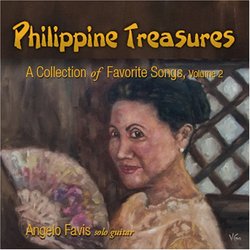| All Artists: Angelo Favis Title: Philippine Treasures, Volume 2 Members Wishing: 0 Total Copies: 0 Label: VGo Recordings Release Date: 1/1/2007 Genres: International Music, New Age Style: Instrumental Number of Discs: 1 SwapaCD Credits: 1 UPC: 606041243026 |
Search - Angelo Favis :: Philippine Treasures, Volume 2
 | Angelo Favis Philippine Treasures, Volume 2 Genres: International Music, New Age
This second set of Philippine folk songs and kundimans continues the trend set by the first volume: breadth, depth, and variety. We can now also add versatility to the mix, as some of the pieces can be classified as both f... more » |
Larger Image |
CD DetailsSynopsis
Product Description This second set of Philippine folk songs and kundimans continues the trend set by the first volume: breadth, depth, and variety. We can now also add versatility to the mix, as some of the pieces can be classified as both folk and art music. Many of the pieces reflect the many facets of love. Hindi Kita Malimot speaks of undying love, while Dahil Sa Iyo describes how love can make one strong, good, and whole. Lost love and unrequited love are represented by Nasaan Ka Irog, Usahay, Anak Ng Dalita, and Babalik Ka Rin. Nasaan Ka Irog speaks of a doomed love affair. In Anak ng Dalita, being unloved is equivalent to being poor, yet there is a glimmer of hope if one gets noticed by the object of his/her affection. An almost defiant declaration that love will return is the mantra of Babalik Ka Rin, while dreams and despair abound in Usahay. Included here is an instrumental work written by one of the country s most famous songwriters. The Cavatina, originally written for violin and piano in 1921, is one of Abelardo s most famous pieces, and it is the only work here that sounds Filipino and yet does NOT sound Filipino. At this stage in his career, Abelardo was absorbing the idioms of the late Romantic masters and it is evident in the compositions that come from this period. It is a highly skilled composition in the art music tradition and yet accurately and deeply portrays the Filipino soul. The folk tradition is represented by four songs. Ti Ayat Ti Meysa Nga Ubing, which humorously and pointedly admonishes old men to stop looking for love among the young ones, hails from the Ilocos region. The Visayas is represented by Walay Angay, a lament about being abandoned and how one is never meant to be lonely, while Kundiman 1800 is an early 19th-century Tagalog folk tune - also known as Jocelyna ng Baliwag - about a young maiden who is the image of Love personified. The last representative is Lulay, a Tagalog song about a woman who is the paragon of virtue whom her sui Similar CDs
|
CD Reviews"Treasures", the perfect title Peter Gill | Gulf Coast, USA | 07/17/2008 (5 out of 5 stars) "The Volume 1 and 2 series have and are being played over and over again for our own enjoyment and of course for visitors to our home. This is the music of romance, to anyone's ears! If even for a short period of time it transforms our home to an earlier time.
My review will address the discs across three dimensions. First, listenability/pleasure. Some of the finest and truest representations of meaningful and memorable pieces of folk art music. Played in classical style the music evokes memories of simpler and happier times; of being serenaded on the balcony and of welcomed parental involvement in our daily lives, our maturing process. Second, the quality of the music being played. Angelo Favis renders these tunes with such melodic purity it allows you to safely close your eyes to see him play. Favis truly allows you to hear the voices singing the words in your own way.....without them actually cluttering up the music on the disc. His interpretation is flawless and his emotions flow through his fingers to rest on the strings of his instrument. Third, the recording. High quality listening allows the listener to focus on the music and personal images without interruption. This is music for both men and women. Based on your personal life history the music allows the listener to customize their own experience and build private, individual mental images. These recordings are for dinner party background where everyone in the room can fulfill their own needs or for sitting in your favorite listening chair and floating away in the sound. " |

 Track Listings (11) - Disc #1
Track Listings (11) - Disc #1

